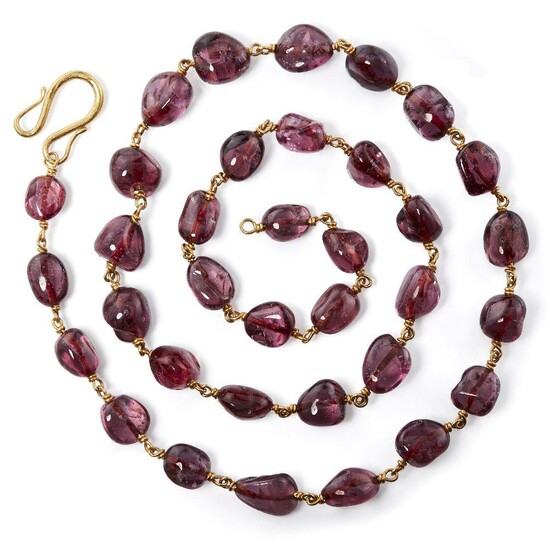A spinel necklace, India, with thirty-seven polished spinels, each weighing between 12-15 carats, with gold wire links and gold hook clasp, 72cm. long, weight 93.4 grams (including the 23.5 carat gold wire) Mughal emperors have had, for centuries...
A spinel necklace, India, with thirty-seven polished spinels, each weighing between 12-15 carats, with gold wire links and gold hook clasp, 72cm. long, weight 93.4 grams (including the 23.5 carat gold wire) Mughal emperors have had, for centuries, a particular love for precious stones. The references found in numerous memoirs and chronicles of this period show the strong cultural belief in gemstone properties. The Timurids, ancestors of the Mughals, introduced the tradition of engraving titles and names on stones of outstanding quality and, along with diamonds and emeralds, large spinel beads were certainly among their favourites. Emperors commissioned special officials to search for spectacular stones, that they would then wear in multiple strand necklaces to adorn their outfits. As much as these gems were a symbol of the opulence and dignity of the empire, they were also treasured as protective talismans. Akbar the Great (1542-1605), third Mughal emperor, collected spinels, wearing them most often directly on the skin, as a 'life-protector' for their blood-red colour, mounted as pendants or bazubands (upper arm bracelets), or simply holding them in his hand. A legend says that the Rulers were to wear three spinels during battles to protect them from injuries and death. Akbar's son, Emperor Jahangir (1569-1627), followed the family tradition as a great connoisseur of gems, and was even described by a contemporary English visitor, the Rev. Edward Terry, as the 'greatest and richest master of precious stones that inhabits the whole earth.' (Pal, op. cit., p. 131). His legendary passion was continued by his son, Shah Jahan, (1592-1666), best known for constructing the Taj Mahal at Agra, one of the most romantic and magnificent architectural wonders in the world, and then by his successor, Emperor Alamgir (1618-1707), also known as Aurangzeb. Although the polish of many of the beads in this necklace appears to be an old soft polish, the absence of any inscriptions or identifying qualities makes it difficult to date these beads precisely. As a group, however, since they are of similar size and shape, it would have taken considerable effort, time and expense to compose. For similar beads see M. Keene, Treasury of the World: Jewelled Arts of India in the Age of the Mughals, London 2001, p. 130 nos. LNS1765 Ja-c.
[ translate ]View it on
Sale price
Estimate
Reserve
Time, Location
Auction House
A spinel necklace, India, with thirty-seven polished spinels, each weighing between 12-15 carats, with gold wire links and gold hook clasp, 72cm. long, weight 93.4 grams (including the 23.5 carat gold wire) Mughal emperors have had, for centuries, a particular love for precious stones. The references found in numerous memoirs and chronicles of this period show the strong cultural belief in gemstone properties. The Timurids, ancestors of the Mughals, introduced the tradition of engraving titles and names on stones of outstanding quality and, along with diamonds and emeralds, large spinel beads were certainly among their favourites. Emperors commissioned special officials to search for spectacular stones, that they would then wear in multiple strand necklaces to adorn their outfits. As much as these gems were a symbol of the opulence and dignity of the empire, they were also treasured as protective talismans. Akbar the Great (1542-1605), third Mughal emperor, collected spinels, wearing them most often directly on the skin, as a 'life-protector' for their blood-red colour, mounted as pendants or bazubands (upper arm bracelets), or simply holding them in his hand. A legend says that the Rulers were to wear three spinels during battles to protect them from injuries and death. Akbar's son, Emperor Jahangir (1569-1627), followed the family tradition as a great connoisseur of gems, and was even described by a contemporary English visitor, the Rev. Edward Terry, as the 'greatest and richest master of precious stones that inhabits the whole earth.' (Pal, op. cit., p. 131). His legendary passion was continued by his son, Shah Jahan, (1592-1666), best known for constructing the Taj Mahal at Agra, one of the most romantic and magnificent architectural wonders in the world, and then by his successor, Emperor Alamgir (1618-1707), also known as Aurangzeb. Although the polish of many of the beads in this necklace appears to be an old soft polish, the absence of any inscriptions or identifying qualities makes it difficult to date these beads precisely. As a group, however, since they are of similar size and shape, it would have taken considerable effort, time and expense to compose. For similar beads see M. Keene, Treasury of the World: Jewelled Arts of India in the Age of the Mughals, London 2001, p. 130 nos. LNS1765 Ja-c.
[ translate ]


